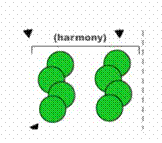Current Works
If I’m not real good, I prefer to be just frankly no good. I don’t want to disguise myself as a man of learning.
I don’t want to be the representative of a hobby. I want to be what nature made me—no good.
– Aldous Huxley, Point Counter Point (London: Chatto & Windus, 1952), pp. 91-92.
(Note: Images of the score are available under the composer Benoit Granier’s text below.)
“Dissociative Amnesia, subtype psychogenic fugue, is characterized by reversible amnesia. This state usually lasts from a few hours to numerous days, although it can also last for months or even longer.” Typically, it involves unplanned travel or wandering, and in some cases the person adapts a new identity.
My fugal composition tries to recreate that feeling of wandering, or this form of amnesia’s unplanned travel, within the closed structure of a fugue. It also uses the formal organization of Huxley’s work in that it creates a kind of musical discussion that evolves over time through a series of exchanges and arguments. Instead of a single line or motive, there are a number of interlinked storylines within a central theme.
Similarly, a fugue is a contrapuntal piece of music that uses melodies, which are then developed episodically using composition techniques such as imitations. Thus, following Huxley’s books and ideas, the present composition features six themes (sounds that were chosen on the basis of their different spectral contents, with each sound having a different color) (see figure 1). These sounds are added together to create a melody that is used throughout the piece as a leitmotif. As seen in the graphic notations created for Mary Sherman’s The Fugue, their appearance follows classical fugue notation with the exception that each of the six notes is replaced by a specific sound – selected to avoid (as much as possible) any harmonic relationship (see figure 2).
Very important to the composition is the recreation of a feeling of wandering, loss and searching. This is created using a drone (a long note that delimitates musical cells). The drone is central to the piece’s form and concept. It is made up of a series of 16 drones – each derived from the six sounds of the leitmotif but of a slightly different timbre (see figure 3).
The drone acts as the basic building block of the composition’s structure and represents the passing of time, where sound is continuously similar, distinctive, unique and at the same time different. It is used to punctuate and emphasize the dramatic effects constructed by the work’s six sounds, or characters, underscoring important changes within the musical process. It is also meant to suggest a discussion, where the audience can imagine the unfolding of acceptation, refusal, identification, argumentation and finally the conclusion of all six characters slowly and calmly pausing as they undergo stages of denial, isolation, anger and acceptance.
Additionally, harmonic materials (based upon the superposition of four notes) create additional motifs where the timbre is constantly changing, building a relationship between the drone cell and the motivic one. The creation of diverse timbres is achieved through serialized filters (see figure 4).
i. David Spiegel et al., “Dissociative Disorders in DSM-5,” Annual Review of Clinical Psychology 9 (2013), pp. 299-326.
The score for Unmentioned, what it can become as though it were not . . . Fugue by Benoit Granier, © 2016.


Figure 1 depicts the melodic construction of the original (acoustic) sketch and the electronic version’s transposition of it. (As seen, the electronic version keeps the melodic contours, rather than adjusting to the strict pitch relationships of the acoustic version).

Figure 2 depicts a motif from the original acoustic sketch and its representation in the electronic version. (Again, the motifs retain only the melodic contours in the electronic version and avoid the precise pitch relationships of the original sketch.)

Figure 3 is an example of the drone in the original sketch and its electronic version’s transposition.

Figure 4 is an example of the harmonic material, built on the four notes’ superimposition and variations.
